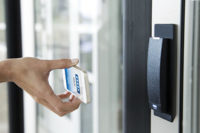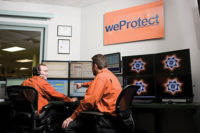Austerity breeds creativity. The economic pinch has informed the choices of end users in all kinds of security, particularly in the past year. The access control customer today is better educated and more tech savvy. The consumer world has taught them that technology can help them not only do more with less, but do it more smoothly, efficiently and cost-effectively than ever before.
“There has been a gravitation of customers exposed to access control to get back to simplicity,” says Bob McKee, vice president of sales and marketing/Americas, Paxton Access, Orlando, Fla. “More and more it is about the interaction and design of the product as opposed to a specific feature. It’s like the iPod. There were a lot of MP3 players available before that, but it was the intuitiveness and simplicity of navigating quickly to what customers wanted that helped the iPod dominate the market.”
End users today are much more informed than in the past, adds Dave Williams, director of business development, Brivo Systems LLC, Bethesda, Md. “We are constantly asked by general passersby at trade shows whether we have browser-based access control (they do). Without a doubt one of the reasons we are being asked that question is customers have really become more educated than in the past. They are looking for lower total cost of ownership in their system and there are some hardware and software interfaces that can get them there. Hardware-wise they are looking for more edge devices, since the majority of them can now provide network drops at the door. From a head end perspective they continue to evaluate their past and future capital expenditures, running through their budget with a fine tooth comb and trying to do everything possible to eliminate the cost and headache associated with client/server architecture.”
Brandon Reich, director of customer marketing, Honeywell Systems, Melville, N.Y., agrees, adding that they are also seeing more sales attributed to add-ons and retrofits than new systems and new construction. “If I were to break up the key features for our customers into end user segments I would put it this way: The traditional commercial end user is primarily concerned with the total cost of ownership; the enterprise end user wants more integration; and critical infrastructure or government is most concerned about compliance and risk mitigation.”
Large or small, end users today are looking at access control with a keener eye for the overall big picture, the smaller but important key features and the up-and-coming hot technologies that will ultimately help them achieve their goals.
The Big Stuff
For the past several years, the “big” access control features that end users desired tended to be integration, open architecture, smart cards (and to some extent biometrics) and browser-based, IP systems. That hasn’t changed. But how they are looking at these things has shifted in the past year.
“Most of our customers are pretty versed in access control,” says integrator Jeff Brandt, senior account executive, Security Corp., Novi, Mich. “They all understand it. But some are now looking towards iClass or smart cards and readers — even though they have no immediate plans to use them — just for the potential of what it will bring them in the future.”
Nothing makes customers more grumpy than lifecycle management, according to Dave Adams, senior product marketing manager, HID, Irvine, Calif. “When things change in their environment and they find out from their integrator that they have to rip and replace a lot of stuff, that is very aggravating. More and more they are looking at products that have a long service life and can change with the times. This is a new way of looking at access control from our perspective: How to build things to factor in growth and flexibility so that when technologies change, the platform can change with it.”
Leon Langlais, director of product management for Kantech (a Tyco company), Montreal area, Canada, agrees. “Customers want their investment to be protected, so that when they invest, it is a long-term solution that has the flexibility to build their business processes around their security system.”
One of the features that end users should be looking for, if they are not already, is architecture that is both backwards and upwards compatible, says Mas Kosaka, president, PCSC, Torrance, Calif. “Every day we see requests for a new access control solution, but odds are good that these customers already have a system and they are not able to upgrade it with the latest technology advances. Investing in a security system should not be considered ‘short term.’ The ability for a manufacturer to guarantee product support and upgrade capabilities is a very important feature and should not be overlooked.”
Matrix Systems, Miamisburg, Ohio, has been a manufacturer for 30 years, but has also been an integrator for that time as well, says Bob Mosler, director of contract sales. On the integrator side, they are also aware of the importance of being able to use multiple types of hardware or control panels in a backwards-compatible way. “We can take over existing systems that have used that hardware in the past at a very low upfront cost to the end user.”
Integration, particularly with video, is still a top draw feature-wise, but now it is much more exciting if the video can be pulled up directly from the Web or from a link inside a report. In addition, integration with other systems — particularly building and energy management systems, IT and other non-traditional security solutions — is also becoming a point of interest for end users.
Doing all this using a simple and intuitive graphical user interface or Web interface is another key feature. “End users like to see nice, modern or sleek GUIs that are similar to what they are used to in their consumer electronics at home,” Reich says.
“Often, less than 10 percent of available features on an access system get used,” McKee adds. “Either they are too difficult to navigate or program, or it involves multiple systems to get the information they need.” More and more, customers are realizing this needs to change.
The Small Stuff
Large and exciting features may be the first thing customers look at, but in practice it is the day-to-day operations that make or break a system for the end users. When a manufacturer or integrator can find a way to simplify, automate or manage an area that has been time-consuming or problematic for the end user, that is a winning feature.
For example, many end users are affected by the 2002 Sarbanes-Oxley Act, which requires companies to hold data for a long time as well as track who is coming and going and making changes. Being able to use their access control system to automatically track and report this type of data is a huge help for companies that need to comply with the requirements of the Act.
“Every month and year that goes on, reporting becomes more and more of an important aspect of access control,” Brivo’s Williams says. “End users have asked us to really expand those capabilities. It could be as simple as having the ability to automatically e-mail a report on a specific day of the year without having to physically log in and do that.”
Another useful data-tracking feature is the ability to text or page or notify via e-mail anything that happens within the access control system, says Gary Staley, national sales manager, RS2, Munster, Ind.
“I think this ties to the trend to continually reduce, reduce, reduce the staffing,” adds Dave Barnard, director of dealer development, RS2. “By being able to have the system automatically send an e-mail to the right department, or send alarms to the department manager, that is a very powerful thing.”
Sometimes the simple features draw in a customer and end up creating a larger system over time.
As executive director of maintenance operation for Wayne Westland Community School District, Wayne County, Mich., Tony Spisak initially looked to access control for a simple process. “Back when we first started we really just wanted access control to shut off the alarm with the same card. But from there it escalated into getting everyone a card and adding more doors. Then we networked it all.”
Most recently the school upgraded its software to add panic buttons to all the buildings that would shut off all cards in the event of an emergency — another smaller, but powerful feature.
“What I find is that clients are looking for better security controls for their business,” says Doug Penson, president, Secur-U Inc., an integrator based in Milton, Ontario. “They want to manage their security more seamlessly.”
Ease of management is key, adds Brad Aikin, product manager for commercial electronic locks, Schlage Brand, Ingersoll Rand, Carmel, Ind. “For everything from configuring the architecture to the interface, to what someone does at the door, customers are looking for ways to make it more flexible and simple. They want us to demystify and take the intimidation out of it.”
For example, active directory is a feature that allows facility card management tasks to be performed automatically and without the need to manually enter the changes into the system, Kosaka says.
“There has been a lot of buzz about integration with active directory for automatic updates to flow all the way through the customer’s system from the hiring to termination of employees,” RS2’s Barnard adds.
Similarly, integration with systems such as Outlook can allow end users to lock and unlock zones using scheduling programs, says Wayne Jared, president of Infinias, Indianapolis. “Outlook is very flexible in its ability to schedule and deliver convenience beyond just security. It is not so much that customers want more stringent security as they want more ability to manage their facility better.”
The Cutting Edge Stuff
Some of the newest features available in access control are literally at the edge. Edge devices, which use the customer’s network to take control out to the door, are a relatively recent addition to the access control plate and increase exponentially in popularity every year as customers understand the cost savings involved. Similarly, Power over Ethernet (PoE) devices and wireless locks all use networks and newer access technology to accomplish the task more simply and efficiently for some applications.
“Wireless has become more acceptable and customers understand where it can add a lot of value,” Schlage’s Aikin says. “We get a lot of requests for wireless devices that can respond and be as close to wired as possible, but still be wireless. The ability to drive a command to a wireless lock and not have to wait for it to wake up has really helped.
“It is also a factor that the availability of funds is still going in a downward direction, which has further heightened the value of the cost of ownership for online access compared to hardwired. The focus on the bottom line has raised the appreciation of online access and how it can save the end user money.”
The consumer-educated customer is also very aware of the potential of some other technologies in the access control sphere. “With all the communication technology available today such as iPhones, iPads and smart phones, I am often asked if we ‘have an app for that,’” Staley says.
And, in fact, several manufacturers go even further. Near Field Communication (NFC) is a technology increasingly being added to readers that will read the chip on a smart phone and turn it into an access control device.
“We just introduced a cell phone reader,” McKee says. “We also have an iPhone application that uses both the ability to do roll call to determine who is in and out of a facility as well as opening the door remotely and doing time and attendance for virtual offices.”
HID is being asked to produce secure credentials that can be used on NFC phones as well as cards and keyfobs, Adams says. “People want to use their phones, but they want to have a high degree of security when it comes to their identity.” Whether via PIN or biometric, NFC devices can be secured.
Another new feature in demand is sustainability, or “green” products. “We have heard end users say ‘give us products that can do this’ and it has become a big driver,” Adams adds. “People trying to build new buildings want products that will give them the edge in getting LEEDs credits (an environmental certification). We have new readers built with 10 percent recyclable material and we also put in intelligent power management that reduces the power by up to 75 percent. For end users it is all about a way to get those credits to make it easier to build what they want.”
Cloud computing is another cutting-edge development affecting access control. Not only is the government developing an initiative to purchase more products using this capability, the consumer market is asking about this virtualization as well, Reich says. “This means that access software can run in a virtual or cloud environment and that has a number of implications, including energy consumption and remote access.”
Penson adds: “Going to cloud-based services means that now access control will be managed like your online banking. Those pain points with traditional access control are solved with full web capabilities on the fly. Customers can have hosted apps, hop online with their BlackBerry or iPhone or computer and manage access from anywhere they are.”
End users today aren’t the same access control consumers they were just a few years ago, McKee says. “The technology being deployed to the consumer world is certainly educating the access control buyer more. I would say everything now is moving into the digital world. We are selling much more IP solutions. People are demanding it and even in the smallest applications they have a network. They are asking for the ability to have a system connect to their existing network and use the PC at their office (or their cell phone or iPad) to control video and access control. There is a much bigger demand for the IP side of the world than ever before.”
|
Primary Concerns Among Market Segments |
|
Traditional Commercial End User: Total Cost of Ownership Enterprise End User: More Integration Government/Critical Infrastructure: Compliance & Risk Mitigation |
|
Dealer-Friendly Features |
|
Not all access control features benefit just the end users. Some of the newer developments in access control are designed to help the dealer as well. “With today’s economy so tight, dealers have to find ways to compete effectively,” says Bob McKee, vice president of sales and marketing/Americas, Paxton Access. “Margins become so critical to how you survive in the marketplace. Having a system predicated on providing the dealer with a simple means of installation where devices are automatically popping up is one way to help. They want to get in on the project, mobilize and get out as quickly as possible so they can bill for it. The dealer feature we see in most demand is simple to install, simple to implement and simple to use.” Brad Aikin, product manager for commercial electronic locks, Schlage Brand, Ingersoll Rand, agrees. “We are trying to simplify things for integrators — particularly the installation and connectivity of the device to make it as plug and play as possible so the installer can be more electrically and mechanically focused and not worry about the configuration of settings. Honeywell has a new software development kit aimed at integrators that allows them to easily communicate and integrate with virtually any type of building system out there, says Brandon Reich, director of customer marketing, Honeywell Systems. “Based on an industry-leading solution, HSDK (Honeywell Software Development Kit) is a set of software tools that enables multiple building systems to talk together with very minimal programming requirements. It cuts the time needed to develop integration from weeks down to hours.” Secur-U Inc., an integrator based in Milton, Ontario, recently formed a sister company called My Managed Security Inc., says Doug Penson, president. “Based on the principals of hattrix (a managed access offering from Kantech), it allows dealers to come on and be part of our offering. It allows them to get in at minimal cost to establish RMR in their business and get in the game with the technology that a lot of others are doing. For smaller companies that don’t have the capital to do this themselves, it is a good way to build business.” Leon Langlais, director of product management for Kantech, adds: “Certain dealers have had a rough time with the economic downturn. If they can install and maintain a good base of managed or hosted customers, they have a steady revenue stream. A lot of dealers out there are shopping for better solutions: better priced product, more features and different types of service options.” |










